Employability Skills Report: Tesco, Stratford College, HND Business
VerifiedAdded on 2020/06/04
|13
|3794
|28
Report
AI Summary
This report, prepared for a Stratford College London HND in Business course, examines various employability skills through a case study of Tesco. It begins by defining responsibilities and performance objectives of a customer advisor, evaluating effectiveness, and providing recommendations for improvement. The report then delves into motivational techniques, problem-solving strategies, and communication methods used within the organization. It analyzes team dynamics, explores alternative approaches to task completion, and assesses the impact of implemented strategies. The report also includes an analysis of the roles within a team and how they contribute to shared goals. The report concludes with an overview of the skills and techniques that can be used to improve a business and its workforce. The report references various management theories and provides practical examples, such as the use of mentoring, training, and communication channels, to enhance employee performance and overall business outcomes. The report also includes a memo and a letter to the senior manager addressing problems within the organization.
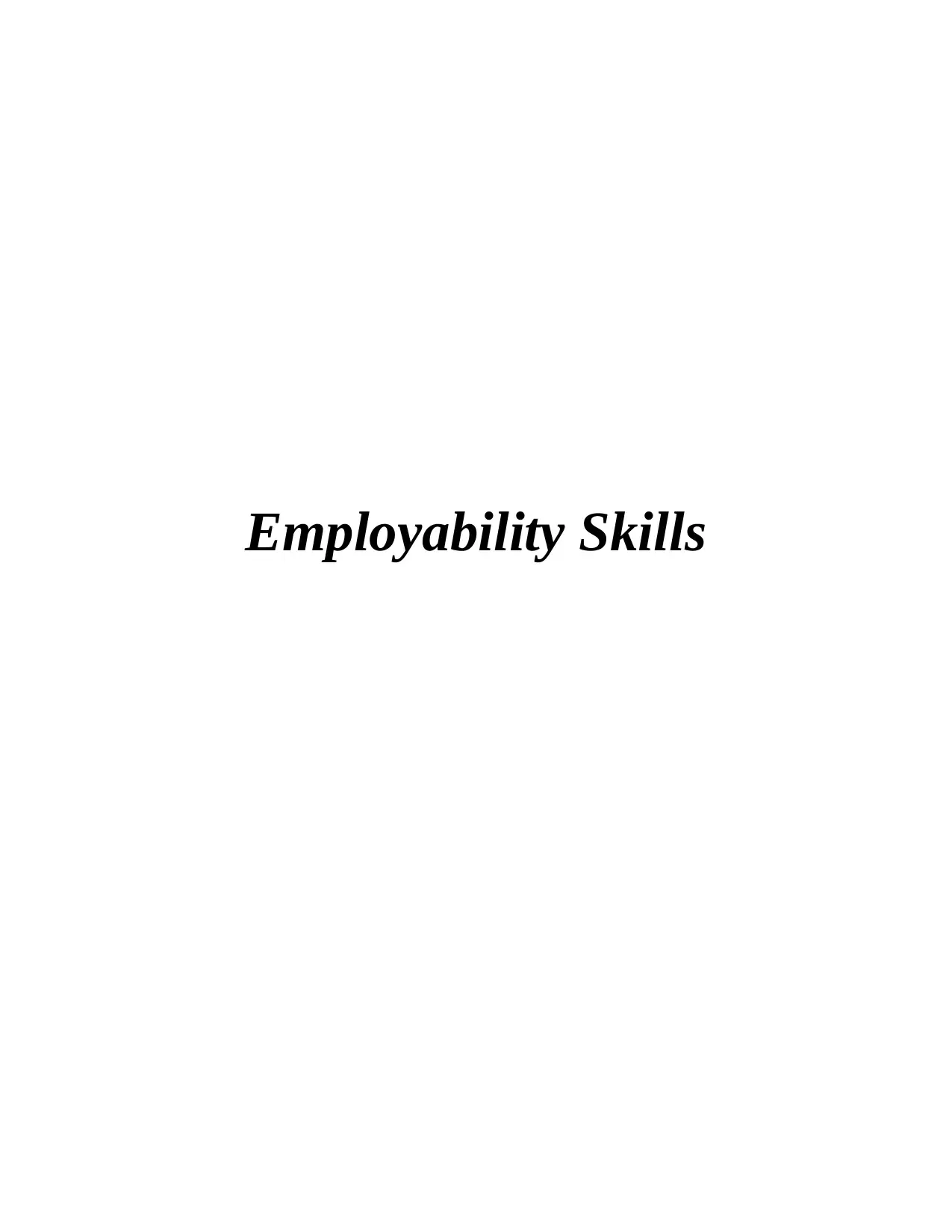
Employability Skills
Paraphrase This Document
Need a fresh take? Get an instant paraphrase of this document with our AI Paraphraser
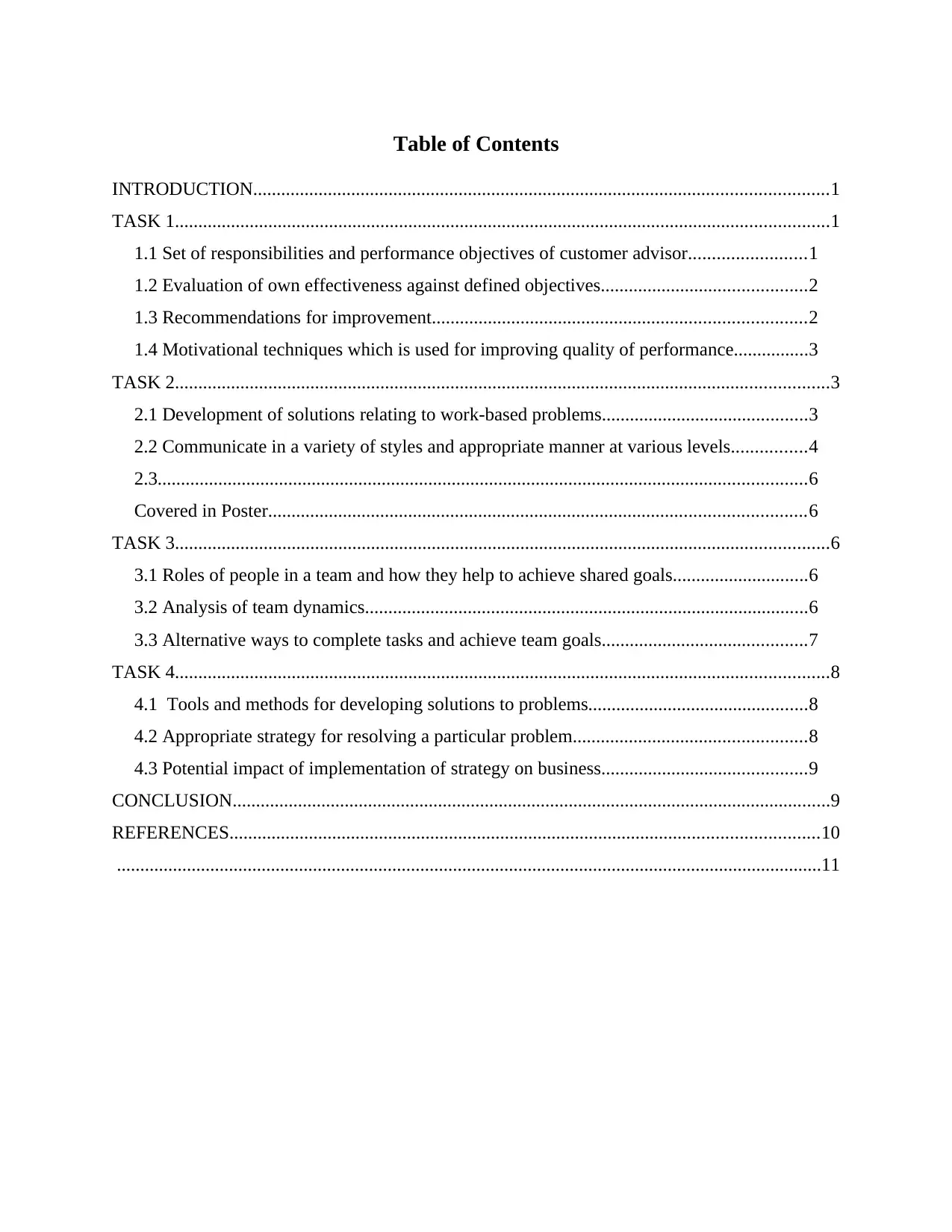
Table of Contents
INTRODUCTION...........................................................................................................................1
TASK 1............................................................................................................................................1
1.1 Set of responsibilities and performance objectives of customer advisor.........................1
1.2 Evaluation of own effectiveness against defined objectives............................................2
1.3 Recommendations for improvement................................................................................2
1.4 Motivational techniques which is used for improving quality of performance................3
TASK 2............................................................................................................................................3
2.1 Development of solutions relating to work-based problems............................................3
2.2 Communicate in a variety of styles and appropriate manner at various levels................4
2.3...........................................................................................................................................6
Covered in Poster...................................................................................................................6
TASK 3............................................................................................................................................6
3.1 Roles of people in a team and how they help to achieve shared goals.............................6
3.2 Analysis of team dynamics...............................................................................................6
3.3 Alternative ways to complete tasks and achieve team goals............................................7
TASK 4............................................................................................................................................8
4.1 Tools and methods for developing solutions to problems...............................................8
4.2 Appropriate strategy for resolving a particular problem..................................................8
4.3 Potential impact of implementation of strategy on business............................................9
CONCLUSION................................................................................................................................9
REFERENCES..............................................................................................................................10
.......................................................................................................................................................11
INTRODUCTION...........................................................................................................................1
TASK 1............................................................................................................................................1
1.1 Set of responsibilities and performance objectives of customer advisor.........................1
1.2 Evaluation of own effectiveness against defined objectives............................................2
1.3 Recommendations for improvement................................................................................2
1.4 Motivational techniques which is used for improving quality of performance................3
TASK 2............................................................................................................................................3
2.1 Development of solutions relating to work-based problems............................................3
2.2 Communicate in a variety of styles and appropriate manner at various levels................4
2.3...........................................................................................................................................6
Covered in Poster...................................................................................................................6
TASK 3............................................................................................................................................6
3.1 Roles of people in a team and how they help to achieve shared goals.............................6
3.2 Analysis of team dynamics...............................................................................................6
3.3 Alternative ways to complete tasks and achieve team goals............................................7
TASK 4............................................................................................................................................8
4.1 Tools and methods for developing solutions to problems...............................................8
4.2 Appropriate strategy for resolving a particular problem..................................................8
4.3 Potential impact of implementation of strategy on business............................................9
CONCLUSION................................................................................................................................9
REFERENCES..............................................................................................................................10
.......................................................................................................................................................11
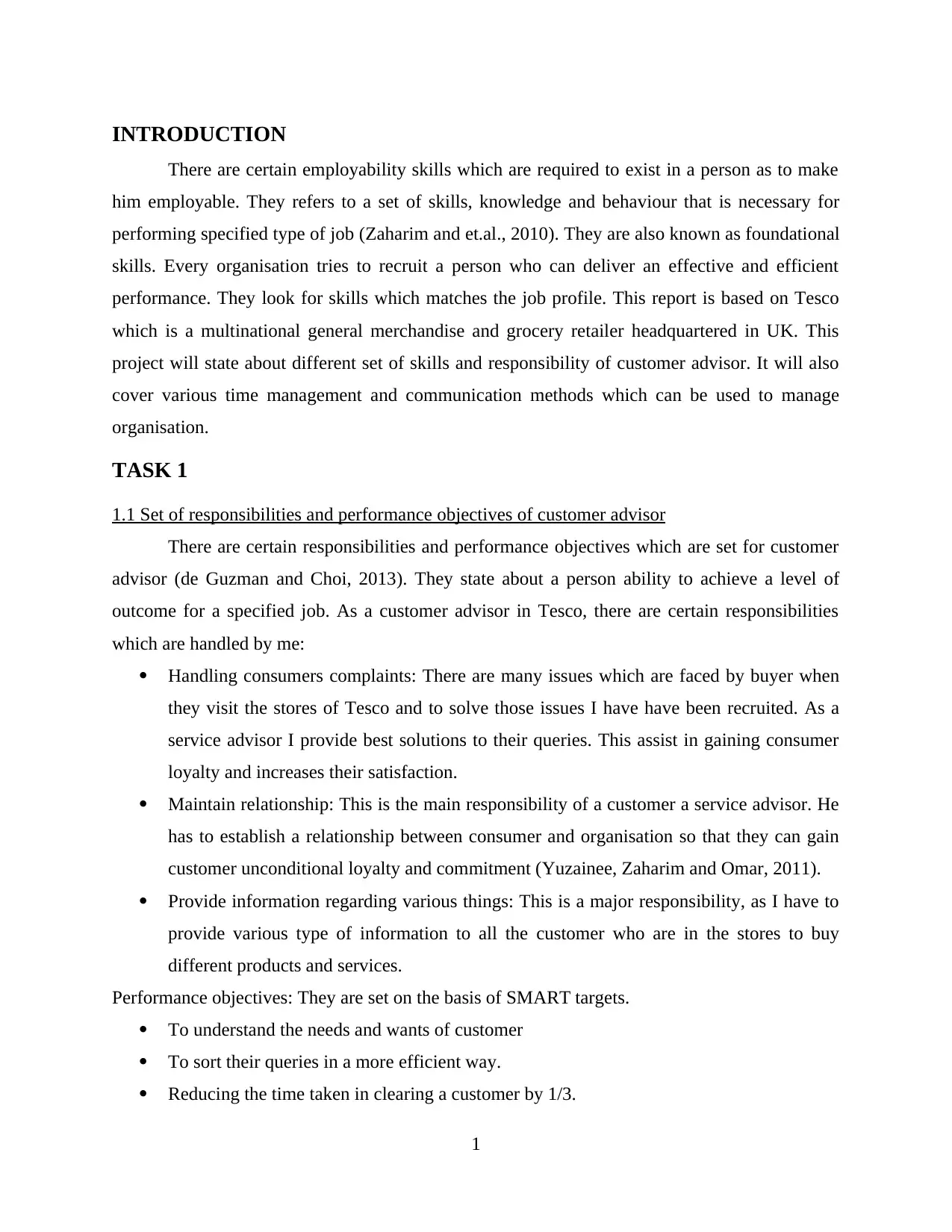
INTRODUCTION
There are certain employability skills which are required to exist in a person as to make
him employable. They refers to a set of skills, knowledge and behaviour that is necessary for
performing specified type of job (Zaharim and et.al., 2010). They are also known as foundational
skills. Every organisation tries to recruit a person who can deliver an effective and efficient
performance. They look for skills which matches the job profile. This report is based on Tesco
which is a multinational general merchandise and grocery retailer headquartered in UK. This
project will state about different set of skills and responsibility of customer advisor. It will also
cover various time management and communication methods which can be used to manage
organisation.
TASK 1
1.1 Set of responsibilities and performance objectives of customer advisor
There are certain responsibilities and performance objectives which are set for customer
advisor (de Guzman and Choi, 2013). They state about a person ability to achieve a level of
outcome for a specified job. As a customer advisor in Tesco, there are certain responsibilities
which are handled by me:
Handling consumers complaints: There are many issues which are faced by buyer when
they visit the stores of Tesco and to solve those issues I have have been recruited. As a
service advisor I provide best solutions to their queries. This assist in gaining consumer
loyalty and increases their satisfaction.
Maintain relationship: This is the main responsibility of a customer a service advisor. He
has to establish a relationship between consumer and organisation so that they can gain
customer unconditional loyalty and commitment (Yuzainee, Zaharim and Omar, 2011).
Provide information regarding various things: This is a major responsibility, as I have to
provide various type of information to all the customer who are in the stores to buy
different products and services.
Performance objectives: They are set on the basis of SMART targets.
To understand the needs and wants of customer
To sort their queries in a more efficient way.
Reducing the time taken in clearing a customer by 1/3.
1
There are certain employability skills which are required to exist in a person as to make
him employable. They refers to a set of skills, knowledge and behaviour that is necessary for
performing specified type of job (Zaharim and et.al., 2010). They are also known as foundational
skills. Every organisation tries to recruit a person who can deliver an effective and efficient
performance. They look for skills which matches the job profile. This report is based on Tesco
which is a multinational general merchandise and grocery retailer headquartered in UK. This
project will state about different set of skills and responsibility of customer advisor. It will also
cover various time management and communication methods which can be used to manage
organisation.
TASK 1
1.1 Set of responsibilities and performance objectives of customer advisor
There are certain responsibilities and performance objectives which are set for customer
advisor (de Guzman and Choi, 2013). They state about a person ability to achieve a level of
outcome for a specified job. As a customer advisor in Tesco, there are certain responsibilities
which are handled by me:
Handling consumers complaints: There are many issues which are faced by buyer when
they visit the stores of Tesco and to solve those issues I have have been recruited. As a
service advisor I provide best solutions to their queries. This assist in gaining consumer
loyalty and increases their satisfaction.
Maintain relationship: This is the main responsibility of a customer a service advisor. He
has to establish a relationship between consumer and organisation so that they can gain
customer unconditional loyalty and commitment (Yuzainee, Zaharim and Omar, 2011).
Provide information regarding various things: This is a major responsibility, as I have to
provide various type of information to all the customer who are in the stores to buy
different products and services.
Performance objectives: They are set on the basis of SMART targets.
To understand the needs and wants of customer
To sort their queries in a more efficient way.
Reducing the time taken in clearing a customer by 1/3.
1
⊘ This is a preview!⊘
Do you want full access?
Subscribe today to unlock all pages.

Trusted by 1+ million students worldwide
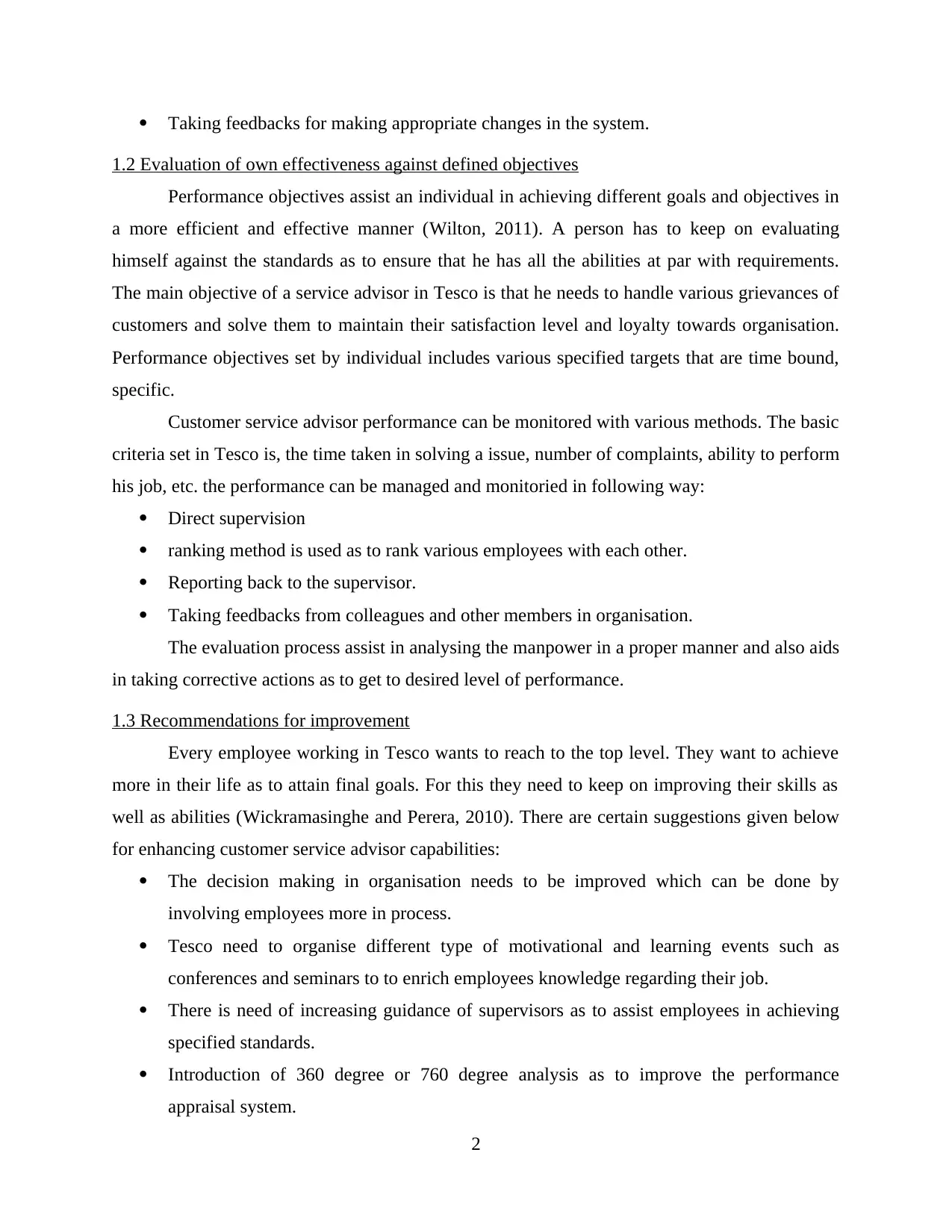
Taking feedbacks for making appropriate changes in the system.
1.2 Evaluation of own effectiveness against defined objectives
Performance objectives assist an individual in achieving different goals and objectives in
a more efficient and effective manner (Wilton, 2011). A person has to keep on evaluating
himself against the standards as to ensure that he has all the abilities at par with requirements.
The main objective of a service advisor in Tesco is that he needs to handle various grievances of
customers and solve them to maintain their satisfaction level and loyalty towards organisation.
Performance objectives set by individual includes various specified targets that are time bound,
specific.
Customer service advisor performance can be monitored with various methods. The basic
criteria set in Tesco is, the time taken in solving a issue, number of complaints, ability to perform
his job, etc. the performance can be managed and monitoried in following way:
Direct supervision
ranking method is used as to rank various employees with each other.
Reporting back to the supervisor.
Taking feedbacks from colleagues and other members in organisation.
The evaluation process assist in analysing the manpower in a proper manner and also aids
in taking corrective actions as to get to desired level of performance.
1.3 Recommendations for improvement
Every employee working in Tesco wants to reach to the top level. They want to achieve
more in their life as to attain final goals. For this they need to keep on improving their skills as
well as abilities (Wickramasinghe and Perera, 2010). There are certain suggestions given below
for enhancing customer service advisor capabilities:
The decision making in organisation needs to be improved which can be done by
involving employees more in process.
Tesco need to organise different type of motivational and learning events such as
conferences and seminars to to enrich employees knowledge regarding their job.
There is need of increasing guidance of supervisors as to assist employees in achieving
specified standards.
Introduction of 360 degree or 760 degree analysis as to improve the performance
appraisal system.
2
1.2 Evaluation of own effectiveness against defined objectives
Performance objectives assist an individual in achieving different goals and objectives in
a more efficient and effective manner (Wilton, 2011). A person has to keep on evaluating
himself against the standards as to ensure that he has all the abilities at par with requirements.
The main objective of a service advisor in Tesco is that he needs to handle various grievances of
customers and solve them to maintain their satisfaction level and loyalty towards organisation.
Performance objectives set by individual includes various specified targets that are time bound,
specific.
Customer service advisor performance can be monitored with various methods. The basic
criteria set in Tesco is, the time taken in solving a issue, number of complaints, ability to perform
his job, etc. the performance can be managed and monitoried in following way:
Direct supervision
ranking method is used as to rank various employees with each other.
Reporting back to the supervisor.
Taking feedbacks from colleagues and other members in organisation.
The evaluation process assist in analysing the manpower in a proper manner and also aids
in taking corrective actions as to get to desired level of performance.
1.3 Recommendations for improvement
Every employee working in Tesco wants to reach to the top level. They want to achieve
more in their life as to attain final goals. For this they need to keep on improving their skills as
well as abilities (Wickramasinghe and Perera, 2010). There are certain suggestions given below
for enhancing customer service advisor capabilities:
The decision making in organisation needs to be improved which can be done by
involving employees more in process.
Tesco need to organise different type of motivational and learning events such as
conferences and seminars to to enrich employees knowledge regarding their job.
There is need of increasing guidance of supervisors as to assist employees in achieving
specified standards.
Introduction of 360 degree or 760 degree analysis as to improve the performance
appraisal system.
2
Paraphrase This Document
Need a fresh take? Get an instant paraphrase of this document with our AI Paraphraser
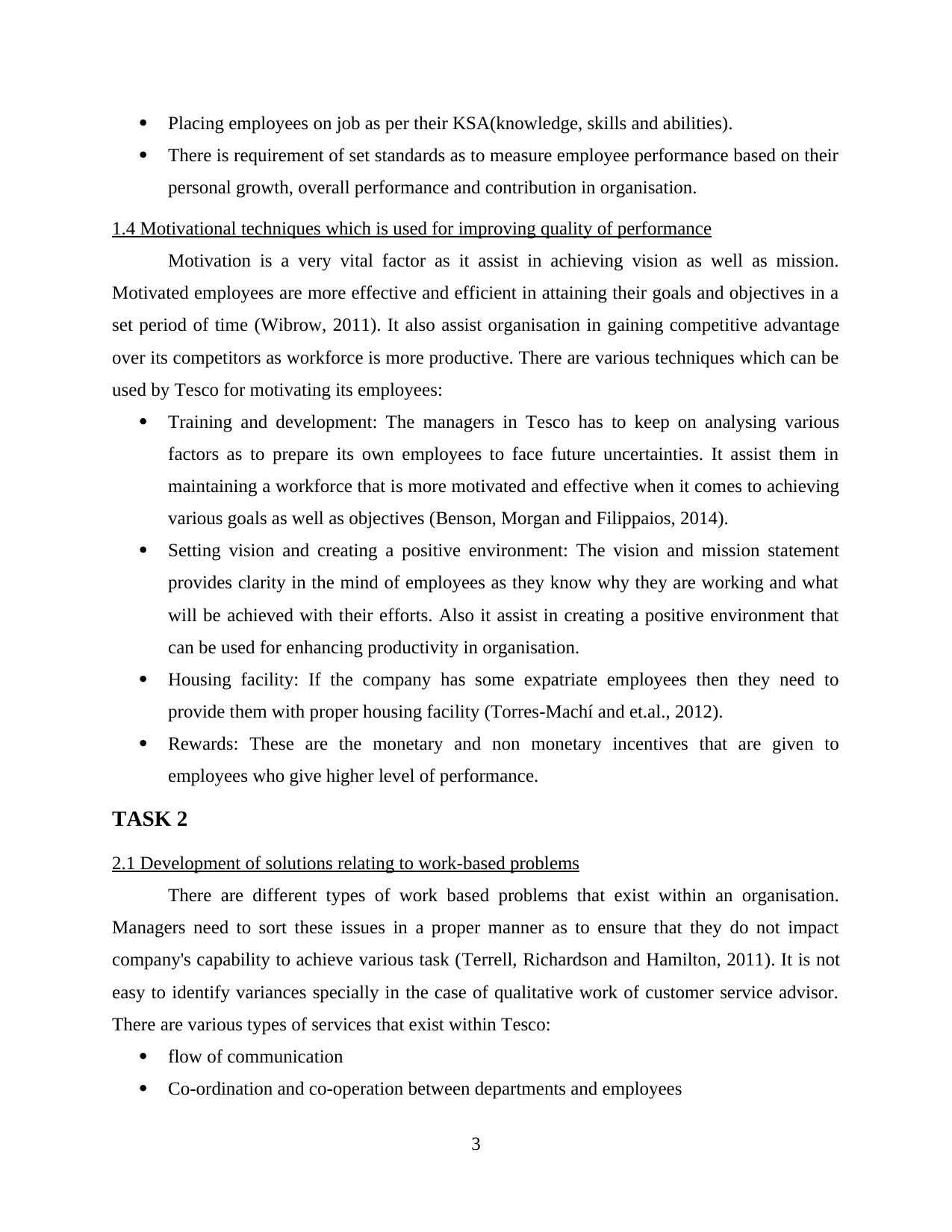
Placing employees on job as per their KSA(knowledge, skills and abilities).
There is requirement of set standards as to measure employee performance based on their
personal growth, overall performance and contribution in organisation.
1.4 Motivational techniques which is used for improving quality of performance
Motivation is a very vital factor as it assist in achieving vision as well as mission.
Motivated employees are more effective and efficient in attaining their goals and objectives in a
set period of time (Wibrow, 2011). It also assist organisation in gaining competitive advantage
over its competitors as workforce is more productive. There are various techniques which can be
used by Tesco for motivating its employees:
Training and development: The managers in Tesco has to keep on analysing various
factors as to prepare its own employees to face future uncertainties. It assist them in
maintaining a workforce that is more motivated and effective when it comes to achieving
various goals as well as objectives (Benson, Morgan and Filippaios, 2014).
Setting vision and creating a positive environment: The vision and mission statement
provides clarity in the mind of employees as they know why they are working and what
will be achieved with their efforts. Also it assist in creating a positive environment that
can be used for enhancing productivity in organisation.
Housing facility: If the company has some expatriate employees then they need to
provide them with proper housing facility (Torres-Machí and et.al., 2012).
Rewards: These are the monetary and non monetary incentives that are given to
employees who give higher level of performance.
TASK 2
2.1 Development of solutions relating to work-based problems
There are different types of work based problems that exist within an organisation.
Managers need to sort these issues in a proper manner as to ensure that they do not impact
company's capability to achieve various task (Terrell, Richardson and Hamilton, 2011). It is not
easy to identify variances specially in the case of qualitative work of customer service advisor.
There are various types of services that exist within Tesco:
flow of communication
Co-ordination and co-operation between departments and employees
3
There is requirement of set standards as to measure employee performance based on their
personal growth, overall performance and contribution in organisation.
1.4 Motivational techniques which is used for improving quality of performance
Motivation is a very vital factor as it assist in achieving vision as well as mission.
Motivated employees are more effective and efficient in attaining their goals and objectives in a
set period of time (Wibrow, 2011). It also assist organisation in gaining competitive advantage
over its competitors as workforce is more productive. There are various techniques which can be
used by Tesco for motivating its employees:
Training and development: The managers in Tesco has to keep on analysing various
factors as to prepare its own employees to face future uncertainties. It assist them in
maintaining a workforce that is more motivated and effective when it comes to achieving
various goals as well as objectives (Benson, Morgan and Filippaios, 2014).
Setting vision and creating a positive environment: The vision and mission statement
provides clarity in the mind of employees as they know why they are working and what
will be achieved with their efforts. Also it assist in creating a positive environment that
can be used for enhancing productivity in organisation.
Housing facility: If the company has some expatriate employees then they need to
provide them with proper housing facility (Torres-Machí and et.al., 2012).
Rewards: These are the monetary and non monetary incentives that are given to
employees who give higher level of performance.
TASK 2
2.1 Development of solutions relating to work-based problems
There are different types of work based problems that exist within an organisation.
Managers need to sort these issues in a proper manner as to ensure that they do not impact
company's capability to achieve various task (Terrell, Richardson and Hamilton, 2011). It is not
easy to identify variances specially in the case of qualitative work of customer service advisor.
There are various types of services that exist within Tesco:
flow of communication
Co-ordination and co-operation between departments and employees
3
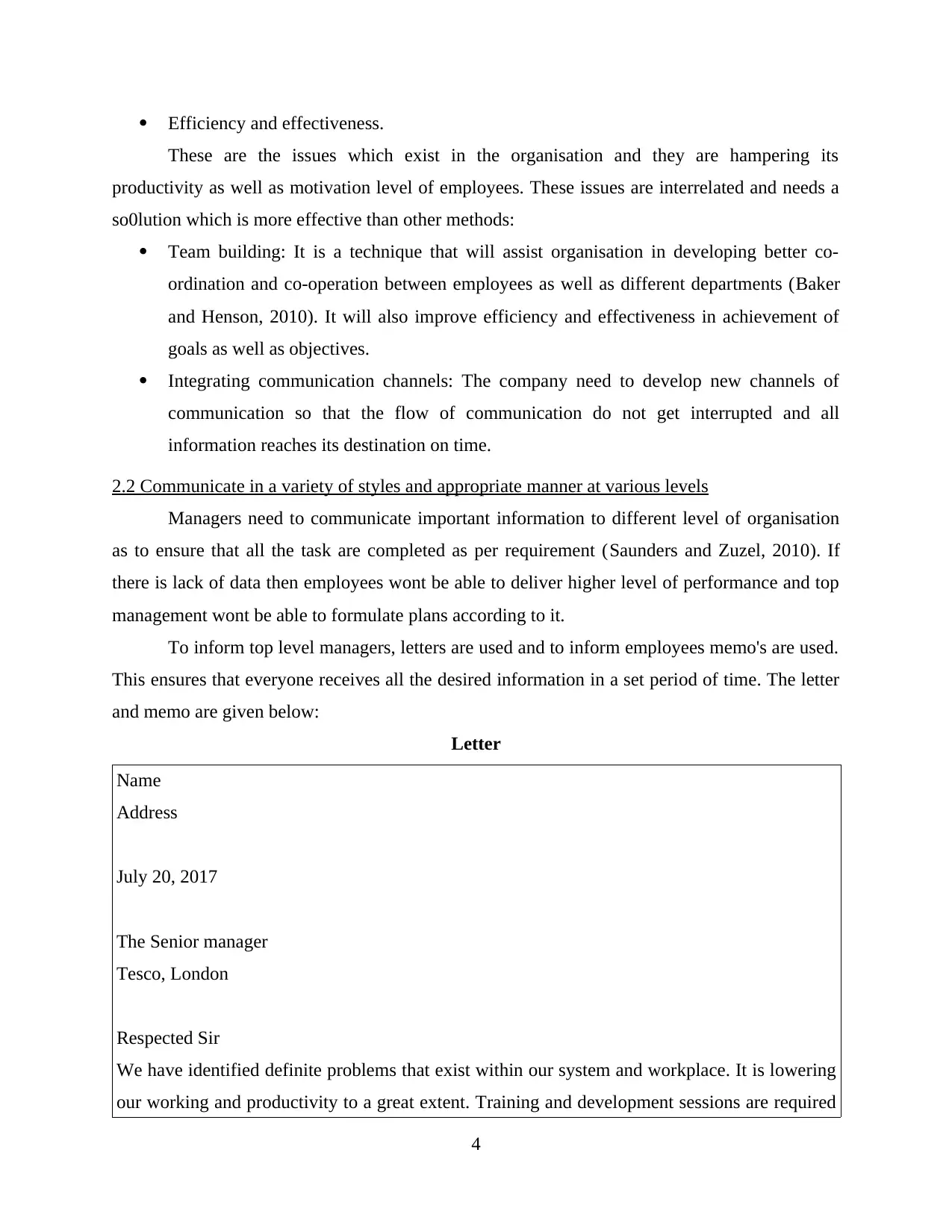
Efficiency and effectiveness.
These are the issues which exist in the organisation and they are hampering its
productivity as well as motivation level of employees. These issues are interrelated and needs a
so0lution which is more effective than other methods:
Team building: It is a technique that will assist organisation in developing better co-
ordination and co-operation between employees as well as different departments (Baker
and Henson, 2010). It will also improve efficiency and effectiveness in achievement of
goals as well as objectives.
Integrating communication channels: The company need to develop new channels of
communication so that the flow of communication do not get interrupted and all
information reaches its destination on time.
2.2 Communicate in a variety of styles and appropriate manner at various levels
Managers need to communicate important information to different level of organisation
as to ensure that all the task are completed as per requirement (Saunders and Zuzel, 2010). If
there is lack of data then employees wont be able to deliver higher level of performance and top
management wont be able to formulate plans according to it.
To inform top level managers, letters are used and to inform employees memo's are used.
This ensures that everyone receives all the desired information in a set period of time. The letter
and memo are given below:
Letter
Name
Address
July 20, 2017
The Senior manager
Tesco, London
Respected Sir
We have identified definite problems that exist within our system and workplace. It is lowering
our working and productivity to a great extent. Training and development sessions are required
4
These are the issues which exist in the organisation and they are hampering its
productivity as well as motivation level of employees. These issues are interrelated and needs a
so0lution which is more effective than other methods:
Team building: It is a technique that will assist organisation in developing better co-
ordination and co-operation between employees as well as different departments (Baker
and Henson, 2010). It will also improve efficiency and effectiveness in achievement of
goals as well as objectives.
Integrating communication channels: The company need to develop new channels of
communication so that the flow of communication do not get interrupted and all
information reaches its destination on time.
2.2 Communicate in a variety of styles and appropriate manner at various levels
Managers need to communicate important information to different level of organisation
as to ensure that all the task are completed as per requirement (Saunders and Zuzel, 2010). If
there is lack of data then employees wont be able to deliver higher level of performance and top
management wont be able to formulate plans according to it.
To inform top level managers, letters are used and to inform employees memo's are used.
This ensures that everyone receives all the desired information in a set period of time. The letter
and memo are given below:
Letter
Name
Address
July 20, 2017
The Senior manager
Tesco, London
Respected Sir
We have identified definite problems that exist within our system and workplace. It is lowering
our working and productivity to a great extent. Training and development sessions are required
4
⊘ This is a preview!⊘
Do you want full access?
Subscribe today to unlock all pages.

Trusted by 1+ million students worldwide
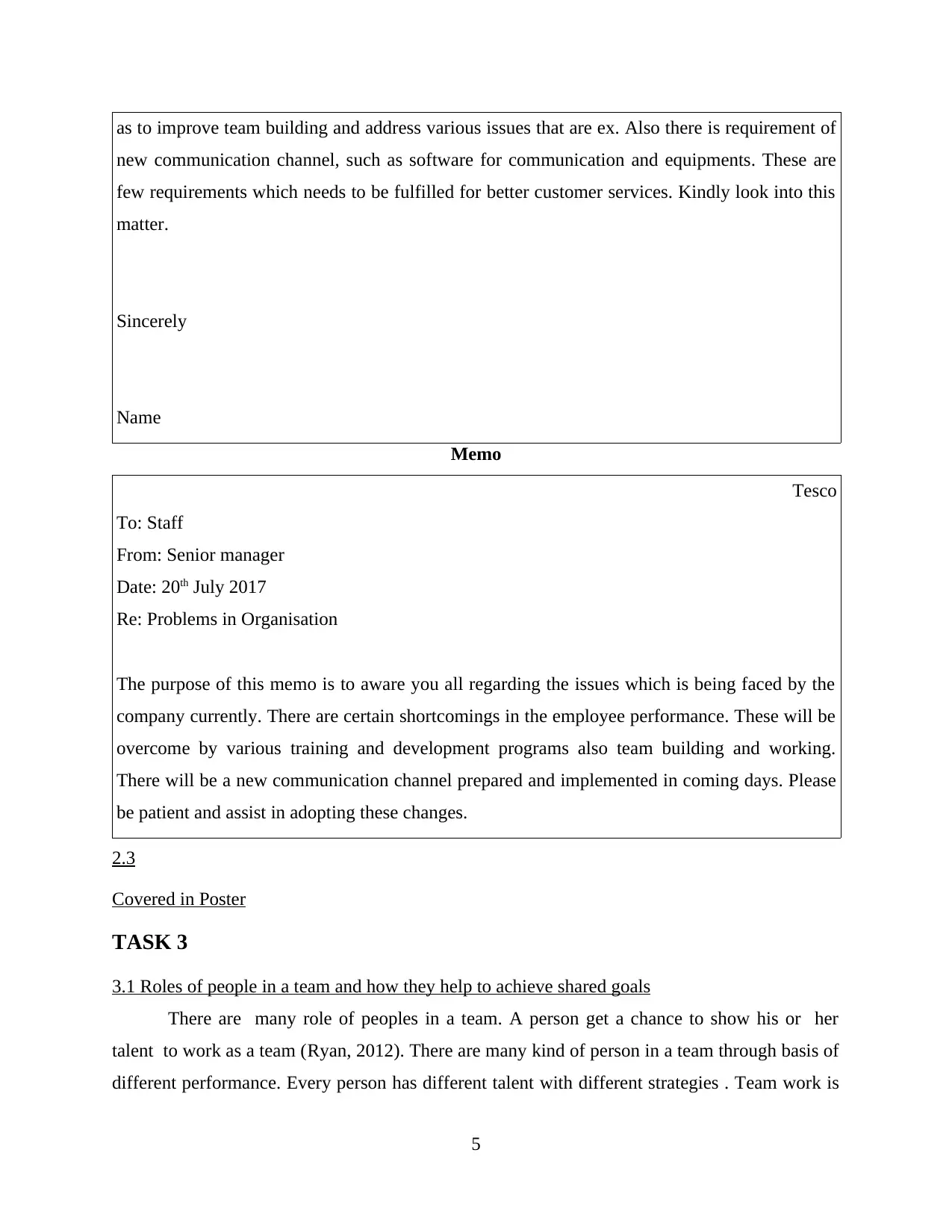
as to improve team building and address various issues that are ex. Also there is requirement of
new communication channel, such as software for communication and equipments. These are
few requirements which needs to be fulfilled for better customer services. Kindly look into this
matter.
Sincerely
Name
Memo
Tesco
To: Staff
From: Senior manager
Date: 20th July 2017
Re: Problems in Organisation
The purpose of this memo is to aware you all regarding the issues which is being faced by the
company currently. There are certain shortcomings in the employee performance. These will be
overcome by various training and development programs also team building and working.
There will be a new communication channel prepared and implemented in coming days. Please
be patient and assist in adopting these changes.
2.3
Covered in Poster
TASK 3
3.1 Roles of people in a team and how they help to achieve shared goals
There are many role of peoples in a team. A person get a chance to show his or her
talent to work as a team (Ryan, 2012). There are many kind of person in a team through basis of
different performance. Every person has different talent with different strategies . Team work is
5
new communication channel, such as software for communication and equipments. These are
few requirements which needs to be fulfilled for better customer services. Kindly look into this
matter.
Sincerely
Name
Memo
Tesco
To: Staff
From: Senior manager
Date: 20th July 2017
Re: Problems in Organisation
The purpose of this memo is to aware you all regarding the issues which is being faced by the
company currently. There are certain shortcomings in the employee performance. These will be
overcome by various training and development programs also team building and working.
There will be a new communication channel prepared and implemented in coming days. Please
be patient and assist in adopting these changes.
2.3
Covered in Poster
TASK 3
3.1 Roles of people in a team and how they help to achieve shared goals
There are many role of peoples in a team. A person get a chance to show his or her
talent to work as a team (Ryan, 2012). There are many kind of person in a team through basis of
different performance. Every person has different talent with different strategies . Team work is
5
Paraphrase This Document
Need a fresh take? Get an instant paraphrase of this document with our AI Paraphraser
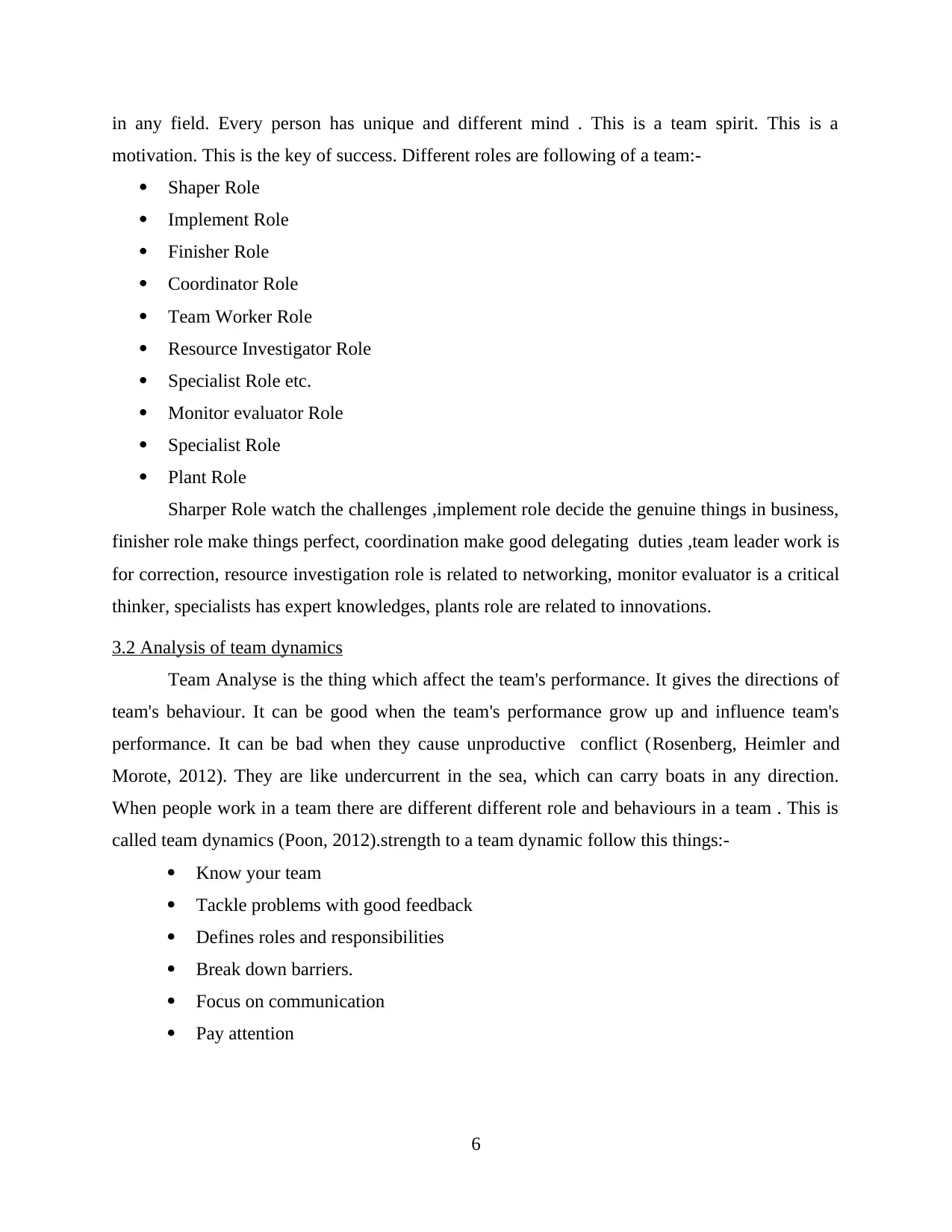
in any field. Every person has unique and different mind . This is a team spirit. This is a
motivation. This is the key of success. Different roles are following of a team:-
Shaper Role
Implement Role
Finisher Role
Coordinator Role
Team Worker Role
Resource Investigator Role
Specialist Role etc.
Monitor evaluator Role
Specialist Role
Plant Role
Sharper Role watch the challenges ,implement role decide the genuine things in business,
finisher role make things perfect, coordination make good delegating duties ,team leader work is
for correction, resource investigation role is related to networking, monitor evaluator is a critical
thinker, specialists has expert knowledges, plants role are related to innovations.
3.2 Analysis of team dynamics
Team Analyse is the thing which affect the team's performance. It gives the directions of
team's behaviour. It can be good when the team's performance grow up and influence team's
performance. It can be bad when they cause unproductive conflict (Rosenberg, Heimler and
Morote, 2012). They are like undercurrent in the sea, which can carry boats in any direction.
When people work in a team there are different different role and behaviours in a team . This is
called team dynamics (Poon, 2012).strength to a team dynamic follow this things:-
Know your team
Tackle problems with good feedback
Defines roles and responsibilities
Break down barriers.
Focus on communication
Pay attention
6
motivation. This is the key of success. Different roles are following of a team:-
Shaper Role
Implement Role
Finisher Role
Coordinator Role
Team Worker Role
Resource Investigator Role
Specialist Role etc.
Monitor evaluator Role
Specialist Role
Plant Role
Sharper Role watch the challenges ,implement role decide the genuine things in business,
finisher role make things perfect, coordination make good delegating duties ,team leader work is
for correction, resource investigation role is related to networking, monitor evaluator is a critical
thinker, specialists has expert knowledges, plants role are related to innovations.
3.2 Analysis of team dynamics
Team Analyse is the thing which affect the team's performance. It gives the directions of
team's behaviour. It can be good when the team's performance grow up and influence team's
performance. It can be bad when they cause unproductive conflict (Rosenberg, Heimler and
Morote, 2012). They are like undercurrent in the sea, which can carry boats in any direction.
When people work in a team there are different different role and behaviours in a team . This is
called team dynamics (Poon, 2012).strength to a team dynamic follow this things:-
Know your team
Tackle problems with good feedback
Defines roles and responsibilities
Break down barriers.
Focus on communication
Pay attention
6
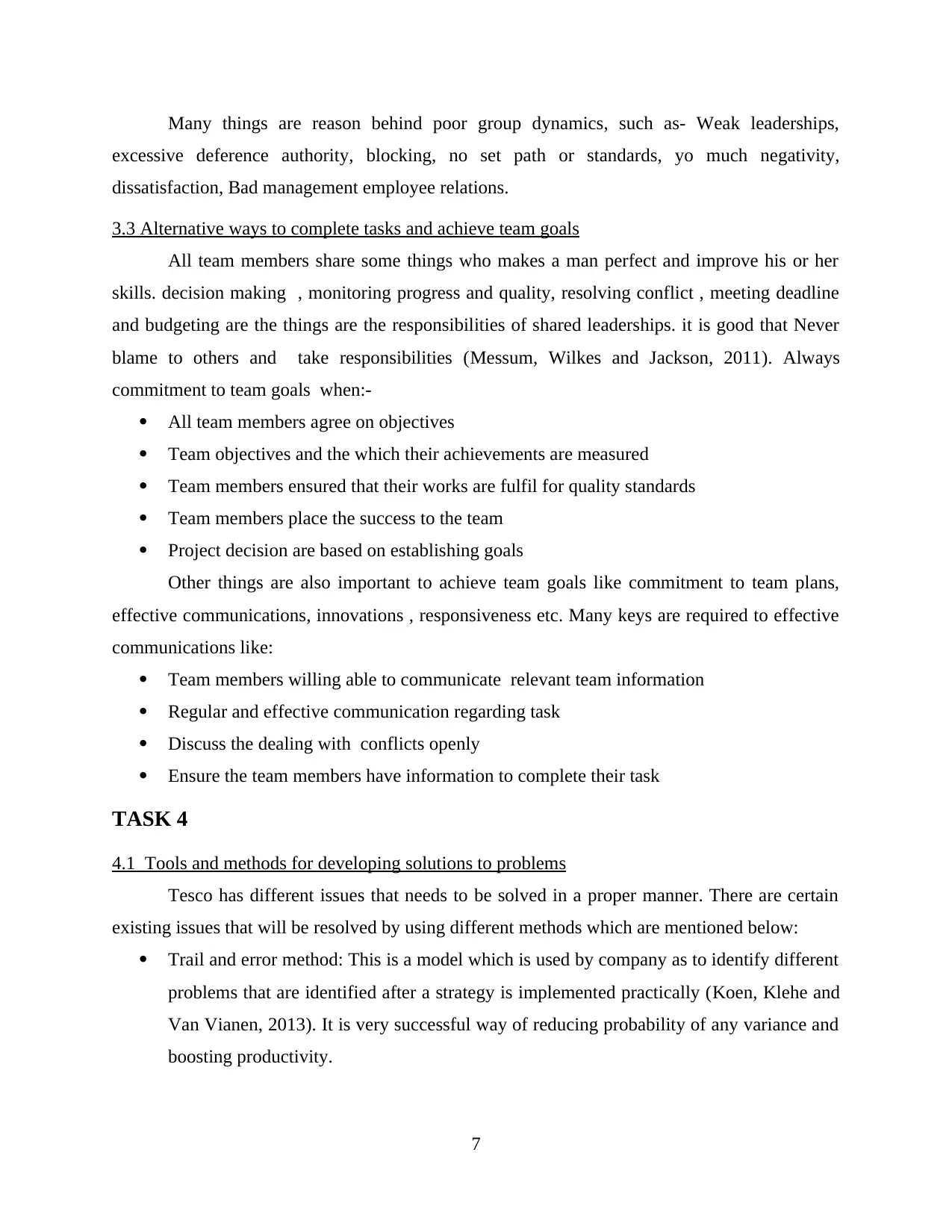
Many things are reason behind poor group dynamics, such as- Weak leaderships,
excessive deference authority, blocking, no set path or standards, yo much negativity,
dissatisfaction, Bad management employee relations.
3.3 Alternative ways to complete tasks and achieve team goals
All team members share some things who makes a man perfect and improve his or her
skills. decision making , monitoring progress and quality, resolving conflict , meeting deadline
and budgeting are the things are the responsibilities of shared leaderships. it is good that Never
blame to others and take responsibilities (Messum, Wilkes and Jackson, 2011). Always
commitment to team goals when:-
All team members agree on objectives
Team objectives and the which their achievements are measured
Team members ensured that their works are fulfil for quality standards
Team members place the success to the team
Project decision are based on establishing goals
Other things are also important to achieve team goals like commitment to team plans,
effective communications, innovations , responsiveness etc. Many keys are required to effective
communications like:
Team members willing able to communicate relevant team information
Regular and effective communication regarding task
Discuss the dealing with conflicts openly
Ensure the team members have information to complete their task
TASK 4
4.1 Tools and methods for developing solutions to problems
Tesco has different issues that needs to be solved in a proper manner. There are certain
existing issues that will be resolved by using different methods which are mentioned below:
Trail and error method: This is a model which is used by company as to identify different
problems that are identified after a strategy is implemented practically (Koen, Klehe and
Van Vianen, 2013). It is very successful way of reducing probability of any variance and
boosting productivity.
7
excessive deference authority, blocking, no set path or standards, yo much negativity,
dissatisfaction, Bad management employee relations.
3.3 Alternative ways to complete tasks and achieve team goals
All team members share some things who makes a man perfect and improve his or her
skills. decision making , monitoring progress and quality, resolving conflict , meeting deadline
and budgeting are the things are the responsibilities of shared leaderships. it is good that Never
blame to others and take responsibilities (Messum, Wilkes and Jackson, 2011). Always
commitment to team goals when:-
All team members agree on objectives
Team objectives and the which their achievements are measured
Team members ensured that their works are fulfil for quality standards
Team members place the success to the team
Project decision are based on establishing goals
Other things are also important to achieve team goals like commitment to team plans,
effective communications, innovations , responsiveness etc. Many keys are required to effective
communications like:
Team members willing able to communicate relevant team information
Regular and effective communication regarding task
Discuss the dealing with conflicts openly
Ensure the team members have information to complete their task
TASK 4
4.1 Tools and methods for developing solutions to problems
Tesco has different issues that needs to be solved in a proper manner. There are certain
existing issues that will be resolved by using different methods which are mentioned below:
Trail and error method: This is a model which is used by company as to identify different
problems that are identified after a strategy is implemented practically (Koen, Klehe and
Van Vianen, 2013). It is very successful way of reducing probability of any variance and
boosting productivity.
7
⊘ This is a preview!⊘
Do you want full access?
Subscribe today to unlock all pages.

Trusted by 1+ million students worldwide
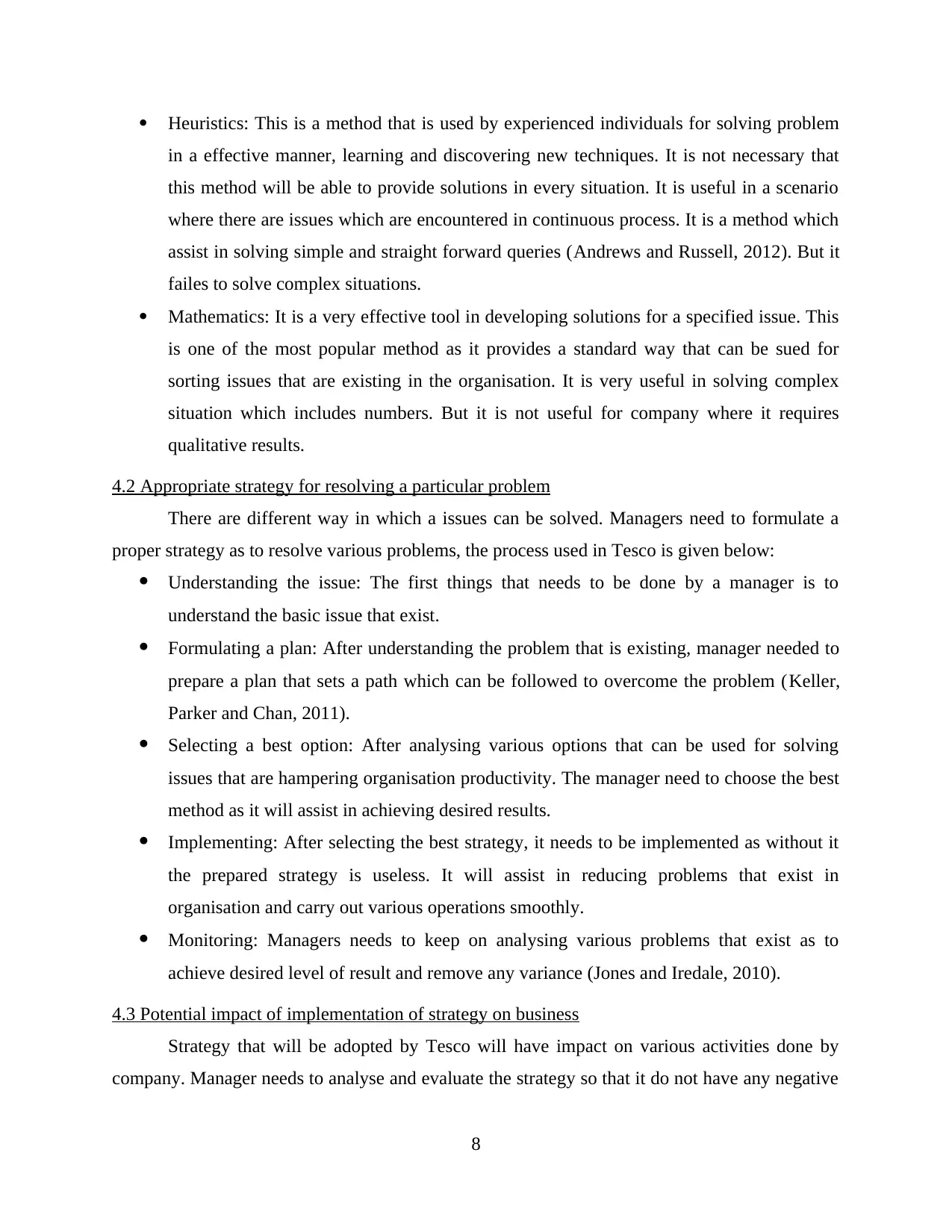
Heuristics: This is a method that is used by experienced individuals for solving problem
in a effective manner, learning and discovering new techniques. It is not necessary that
this method will be able to provide solutions in every situation. It is useful in a scenario
where there are issues which are encountered in continuous process. It is a method which
assist in solving simple and straight forward queries (Andrews and Russell, 2012). But it
failes to solve complex situations.
Mathematics: It is a very effective tool in developing solutions for a specified issue. This
is one of the most popular method as it provides a standard way that can be sued for
sorting issues that are existing in the organisation. It is very useful in solving complex
situation which includes numbers. But it is not useful for company where it requires
qualitative results.
4.2 Appropriate strategy for resolving a particular problem
There are different way in which a issues can be solved. Managers need to formulate a
proper strategy as to resolve various problems, the process used in Tesco is given below:
Understanding the issue: The first things that needs to be done by a manager is to
understand the basic issue that exist.
Formulating a plan: After understanding the problem that is existing, manager needed to
prepare a plan that sets a path which can be followed to overcome the problem (Keller,
Parker and Chan, 2011).
Selecting a best option: After analysing various options that can be used for solving
issues that are hampering organisation productivity. The manager need to choose the best
method as it will assist in achieving desired results.
Implementing: After selecting the best strategy, it needs to be implemented as without it
the prepared strategy is useless. It will assist in reducing problems that exist in
organisation and carry out various operations smoothly.
Monitoring: Managers needs to keep on analysing various problems that exist as to
achieve desired level of result and remove any variance (Jones and Iredale, 2010).
4.3 Potential impact of implementation of strategy on business
Strategy that will be adopted by Tesco will have impact on various activities done by
company. Manager needs to analyse and evaluate the strategy so that it do not have any negative
8
in a effective manner, learning and discovering new techniques. It is not necessary that
this method will be able to provide solutions in every situation. It is useful in a scenario
where there are issues which are encountered in continuous process. It is a method which
assist in solving simple and straight forward queries (Andrews and Russell, 2012). But it
failes to solve complex situations.
Mathematics: It is a very effective tool in developing solutions for a specified issue. This
is one of the most popular method as it provides a standard way that can be sued for
sorting issues that are existing in the organisation. It is very useful in solving complex
situation which includes numbers. But it is not useful for company where it requires
qualitative results.
4.2 Appropriate strategy for resolving a particular problem
There are different way in which a issues can be solved. Managers need to formulate a
proper strategy as to resolve various problems, the process used in Tesco is given below:
Understanding the issue: The first things that needs to be done by a manager is to
understand the basic issue that exist.
Formulating a plan: After understanding the problem that is existing, manager needed to
prepare a plan that sets a path which can be followed to overcome the problem (Keller,
Parker and Chan, 2011).
Selecting a best option: After analysing various options that can be used for solving
issues that are hampering organisation productivity. The manager need to choose the best
method as it will assist in achieving desired results.
Implementing: After selecting the best strategy, it needs to be implemented as without it
the prepared strategy is useless. It will assist in reducing problems that exist in
organisation and carry out various operations smoothly.
Monitoring: Managers needs to keep on analysing various problems that exist as to
achieve desired level of result and remove any variance (Jones and Iredale, 2010).
4.3 Potential impact of implementation of strategy on business
Strategy that will be adopted by Tesco will have impact on various activities done by
company. Manager needs to analyse and evaluate the strategy so that it do not have any negative
8
Paraphrase This Document
Need a fresh take? Get an instant paraphrase of this document with our AI Paraphraser
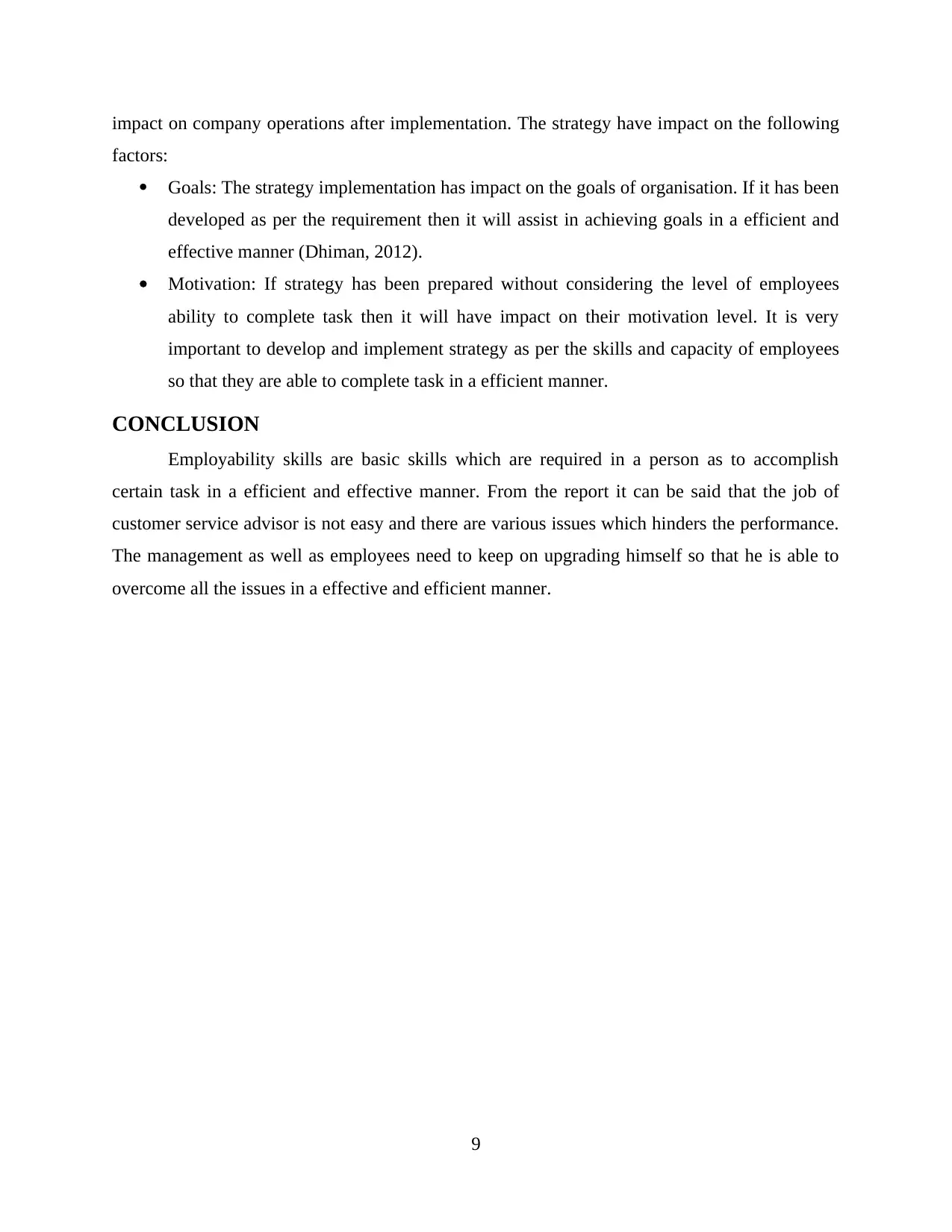
impact on company operations after implementation. The strategy have impact on the following
factors:
Goals: The strategy implementation has impact on the goals of organisation. If it has been
developed as per the requirement then it will assist in achieving goals in a efficient and
effective manner (Dhiman, 2012).
Motivation: If strategy has been prepared without considering the level of employees
ability to complete task then it will have impact on their motivation level. It is very
important to develop and implement strategy as per the skills and capacity of employees
so that they are able to complete task in a efficient manner.
CONCLUSION
Employability skills are basic skills which are required in a person as to accomplish
certain task in a efficient and effective manner. From the report it can be said that the job of
customer service advisor is not easy and there are various issues which hinders the performance.
The management as well as employees need to keep on upgrading himself so that he is able to
overcome all the issues in a effective and efficient manner.
9
factors:
Goals: The strategy implementation has impact on the goals of organisation. If it has been
developed as per the requirement then it will assist in achieving goals in a efficient and
effective manner (Dhiman, 2012).
Motivation: If strategy has been prepared without considering the level of employees
ability to complete task then it will have impact on their motivation level. It is very
important to develop and implement strategy as per the skills and capacity of employees
so that they are able to complete task in a efficient manner.
CONCLUSION
Employability skills are basic skills which are required in a person as to accomplish
certain task in a efficient and effective manner. From the report it can be said that the job of
customer service advisor is not easy and there are various issues which hinders the performance.
The management as well as employees need to keep on upgrading himself so that he is able to
overcome all the issues in a effective and efficient manner.
9
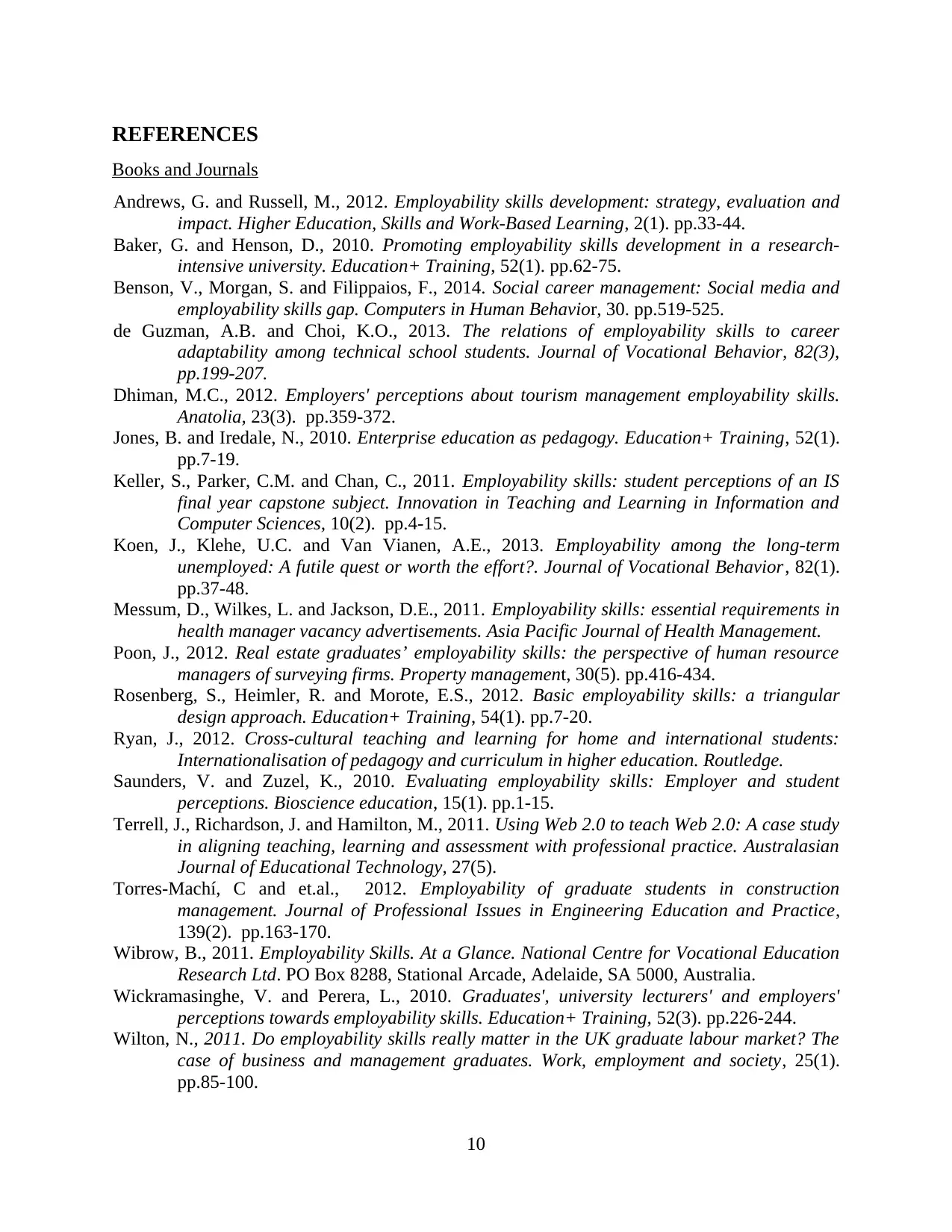
REFERENCES
Books and Journals
Andrews, G. and Russell, M., 2012. Employability skills development: strategy, evaluation and
impact. Higher Education, Skills and Work-Based Learning, 2(1). pp.33-44.
Baker, G. and Henson, D., 2010. Promoting employability skills development in a research-
intensive university. Education+ Training, 52(1). pp.62-75.
Benson, V., Morgan, S. and Filippaios, F., 2014. Social career management: Social media and
employability skills gap. Computers in Human Behavior, 30. pp.519-525.
de Guzman, A.B. and Choi, K.O., 2013. The relations of employability skills to career
adaptability among technical school students. Journal of Vocational Behavior, 82(3),
pp.199-207.
Dhiman, M.C., 2012. Employers' perceptions about tourism management employability skills.
Anatolia, 23(3). pp.359-372.
Jones, B. and Iredale, N., 2010. Enterprise education as pedagogy. Education+ Training, 52(1).
pp.7-19.
Keller, S., Parker, C.M. and Chan, C., 2011. Employability skills: student perceptions of an IS
final year capstone subject. Innovation in Teaching and Learning in Information and
Computer Sciences, 10(2). pp.4-15.
Koen, J., Klehe, U.C. and Van Vianen, A.E., 2013. Employability among the long-term
unemployed: A futile quest or worth the effort?. Journal of Vocational Behavior, 82(1).
pp.37-48.
Messum, D., Wilkes, L. and Jackson, D.E., 2011. Employability skills: essential requirements in
health manager vacancy advertisements. Asia Pacific Journal of Health Management.
Poon, J., 2012. Real estate graduates’ employability skills: the perspective of human resource
managers of surveying firms. Property management, 30(5). pp.416-434.
Rosenberg, S., Heimler, R. and Morote, E.S., 2012. Basic employability skills: a triangular
design approach. Education+ Training, 54(1). pp.7-20.
Ryan, J., 2012. Cross-cultural teaching and learning for home and international students:
Internationalisation of pedagogy and curriculum in higher education. Routledge.
Saunders, V. and Zuzel, K., 2010. Evaluating employability skills: Employer and student
perceptions. Bioscience education, 15(1). pp.1-15.
Terrell, J., Richardson, J. and Hamilton, M., 2011. Using Web 2.0 to teach Web 2.0: A case study
in aligning teaching, learning and assessment with professional practice. Australasian
Journal of Educational Technology, 27(5).
Torres-Machí, C and et.al., 2012. Employability of graduate students in construction
management. Journal of Professional Issues in Engineering Education and Practice,
139(2). pp.163-170.
Wibrow, B., 2011. Employability Skills. At a Glance. National Centre for Vocational Education
Research Ltd. PO Box 8288, Stational Arcade, Adelaide, SA 5000, Australia.
Wickramasinghe, V. and Perera, L., 2010. Graduates', university lecturers' and employers'
perceptions towards employability skills. Education+ Training, 52(3). pp.226-244.
Wilton, N., 2011. Do employability skills really matter in the UK graduate labour market? The
case of business and management graduates. Work, employment and society, 25(1).
pp.85-100.
10
Books and Journals
Andrews, G. and Russell, M., 2012. Employability skills development: strategy, evaluation and
impact. Higher Education, Skills and Work-Based Learning, 2(1). pp.33-44.
Baker, G. and Henson, D., 2010. Promoting employability skills development in a research-
intensive university. Education+ Training, 52(1). pp.62-75.
Benson, V., Morgan, S. and Filippaios, F., 2014. Social career management: Social media and
employability skills gap. Computers in Human Behavior, 30. pp.519-525.
de Guzman, A.B. and Choi, K.O., 2013. The relations of employability skills to career
adaptability among technical school students. Journal of Vocational Behavior, 82(3),
pp.199-207.
Dhiman, M.C., 2012. Employers' perceptions about tourism management employability skills.
Anatolia, 23(3). pp.359-372.
Jones, B. and Iredale, N., 2010. Enterprise education as pedagogy. Education+ Training, 52(1).
pp.7-19.
Keller, S., Parker, C.M. and Chan, C., 2011. Employability skills: student perceptions of an IS
final year capstone subject. Innovation in Teaching and Learning in Information and
Computer Sciences, 10(2). pp.4-15.
Koen, J., Klehe, U.C. and Van Vianen, A.E., 2013. Employability among the long-term
unemployed: A futile quest or worth the effort?. Journal of Vocational Behavior, 82(1).
pp.37-48.
Messum, D., Wilkes, L. and Jackson, D.E., 2011. Employability skills: essential requirements in
health manager vacancy advertisements. Asia Pacific Journal of Health Management.
Poon, J., 2012. Real estate graduates’ employability skills: the perspective of human resource
managers of surveying firms. Property management, 30(5). pp.416-434.
Rosenberg, S., Heimler, R. and Morote, E.S., 2012. Basic employability skills: a triangular
design approach. Education+ Training, 54(1). pp.7-20.
Ryan, J., 2012. Cross-cultural teaching and learning for home and international students:
Internationalisation of pedagogy and curriculum in higher education. Routledge.
Saunders, V. and Zuzel, K., 2010. Evaluating employability skills: Employer and student
perceptions. Bioscience education, 15(1). pp.1-15.
Terrell, J., Richardson, J. and Hamilton, M., 2011. Using Web 2.0 to teach Web 2.0: A case study
in aligning teaching, learning and assessment with professional practice. Australasian
Journal of Educational Technology, 27(5).
Torres-Machí, C and et.al., 2012. Employability of graduate students in construction
management. Journal of Professional Issues in Engineering Education and Practice,
139(2). pp.163-170.
Wibrow, B., 2011. Employability Skills. At a Glance. National Centre for Vocational Education
Research Ltd. PO Box 8288, Stational Arcade, Adelaide, SA 5000, Australia.
Wickramasinghe, V. and Perera, L., 2010. Graduates', university lecturers' and employers'
perceptions towards employability skills. Education+ Training, 52(3). pp.226-244.
Wilton, N., 2011. Do employability skills really matter in the UK graduate labour market? The
case of business and management graduates. Work, employment and society, 25(1).
pp.85-100.
10
⊘ This is a preview!⊘
Do you want full access?
Subscribe today to unlock all pages.

Trusted by 1+ million students worldwide
1 out of 13
Related Documents
Your All-in-One AI-Powered Toolkit for Academic Success.
+13062052269
info@desklib.com
Available 24*7 on WhatsApp / Email
![[object Object]](/_next/static/media/star-bottom.7253800d.svg)
Unlock your academic potential
Copyright © 2020–2025 A2Z Services. All Rights Reserved. Developed and managed by ZUCOL.





